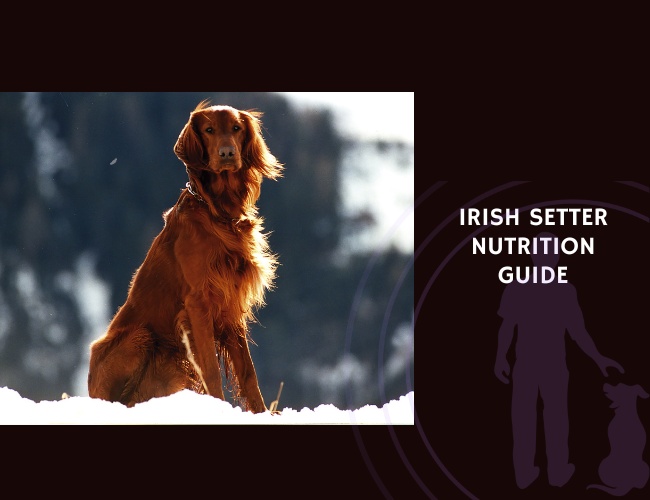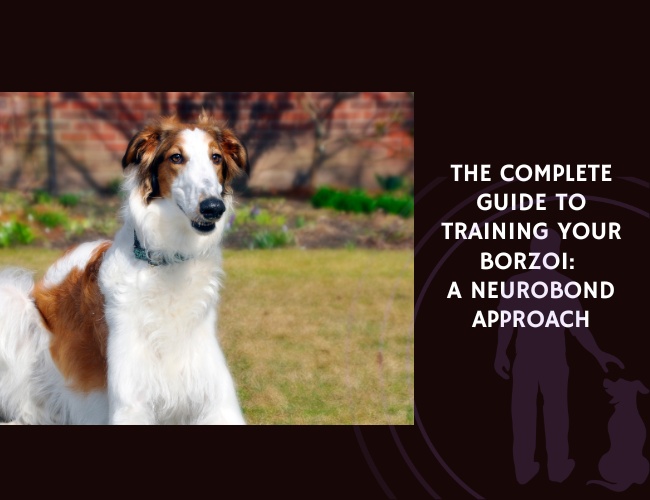Picture this: a flash of mahogany red racing across an open field, ears flowing like silk in the wind. Your Irish Setter isn’t just a pet – they’re an athlete, a companion, and a breed with very specific nutritional needs that have evolved over centuries of selective breeding. Did you know that these elegant dogs were originally bred as tireless hunting companions in the rolling hills of Ireland? This heritage shapes every aspect of their dietary requirements today.
Understanding your Irish Setter’s nutritional needs means recognizing that you’re feeding not just a dog, but a high-performance athlete wrapped in a silky coat. Their boundless energy, combined with breed-specific health considerations, requires a thoughtful approach to nutrition that goes beyond simply filling their bowl. Let us guide you through the fascinating world of Irish Setter nutrition, where science meets the art of keeping your furry friend thriving. 🧡
Breed-Specific Metabolism & Digestive Traits
Understanding Your Irish Setter’s Metabolic Engine
Your Irish Setter’s metabolism runs like a finely-tuned sports car – efficient, powerful, and requiring premium fuel. These athletic dogs possess a notably high metabolic rate that reflects their working heritage. While your neighbor’s couch-loving bulldog might thrive on 1,200 calories a day, your Irish Setter could easily burn through 1,800 calories or more during an active day of running, playing, and being their exuberant selves.
The Science Behind Their Energy Needs
Research on similar sporting breeds suggests that Irish Setters require approximately 25-30% more calories than sedentary breeds of the same size. This increased energy demand stems from several factors:
- Muscle composition: Irish Setters have a higher proportion of lean muscle mass, which burns more calories at rest
- Activity patterns: Even at rest, these dogs exhibit more spontaneous movement and alertness
- Thermoregulation: Their relatively thin skin and single coat mean they expend more energy maintaining body temperature
You might notice your Irish Setter seems to be constantly “on” – this isn’t just personality, it’s biology. Their basal metabolic rate (BMR) reflects thousands of years of selective breeding for endurance hunting.
Digestive System Characteristics
The Irish Setter’s digestive system mirrors their athletic build – long, lean, and efficient. However, this efficiency comes with some unique considerations that every owner should understand.
Stomach Capacity and Structure
Your Irish Setter’s deep chest houses a stomach that, while capacious, sits in a position that makes them susceptible to certain conditions. The stomach’s ability to hold food is impressive, but this very characteristic can become problematic if not managed correctly. Think of it like a pendulum – when full, it can swing more freely, which is why feeding management becomes crucial.
Digestive Transit Time
Irish Setters typically have a faster digestive transit time than many breeds. Food moves through their system in approximately 12-24 hours, compared to up to 30 hours in some larger, less active breeds. This means:
- Nutrients need to be highly bioavailable
- Multiple smaller meals often work better than one large meal
- You’ll notice changes in stool quality quickly if something disagrees with them
Feeding Frequency Considerations
“Should I feed my Irish Setter once or twice a day?” This question has a more complex answer than you might expect. While many dogs do well with twice-daily feeding, Irish Setters often benefit from a different approach.
The Case for Multiple Small Meals
Given their deep chest and active nature, many veterinary nutritionists recommend feeding Irish Setters three smaller meals rather than one or two large ones. This approach offers several benefits:
- Reduced bloat risk: Smaller meal volumes mean less stomach distension
- Sustained energy: More frequent feeding maintains steadier blood sugar levels
- Better digestion: Smaller portions are processed more efficiently
- Behavioral benefits: Multiple feeding times can reduce food-related anxiety
Did you know that in their working days, Irish Setters would often receive small amounts of food throughout a hunting expedition? This historical feeding pattern aligns perfectly with modern recommendations for the breed.
Weight Management and Body Condition
Despite their high activity levels, Irish Setters can be prone to weight gain if their nutrition isn’t carefully managed. Their friendly, food-motivated nature means they’re often talented at convincing you they’re starving – even when they’ve just finished a meal!
Ideal Body Condition
You should be able to feel your Irish Setter’s ribs easily but not see them prominently. From above, they should have a visible waist, and from the side, their abdomen should tuck up. Think of them as marathon runners, not sprinters – lean but not thin.
Common Weight Challenges
Several factors can contribute to weight issues in Irish Setters:
- Overestimating exercise needs: A 30-minute walk doesn’t burn as many calories as you might think
- Training treats: Those “just one more” moments add up quickly
- Age-related changes: Metabolism naturally slows with age
- Post-neutering effects: Hormonal changes can increase appetite and decrease metabolism
Remember, maintaining ideal weight isn’t just about appearance – it’s about joint health, cardiovascular function, and overall quality of life for your beloved companion. 🐾
Macronutrient Requirements
Protein: Building Blocks for Your Athletic Companion
When it comes to protein, your Irish Setter needs more than just quantity – they need quality. These active dogs require protein not just for maintenance, but for supporting their continuous muscle repair and energy production.
Life Stage Protein Requirements
The protein needs of your Irish Setter change dramatically throughout their life:
- Puppyhood (0-12 months): During this critical growth phase, Irish Setter puppies need 22-28% protein (dry matter basis). This higher level supports their rapid development – remember, your puppy will reach about 60% of their adult weight by just six months old!
- Adult Maintenance (1-7 years): Adult Irish Setters thrive on 18-22% protein. This range supports their active lifestyle while preventing excess that could stress their kidneys.
- Senior Years (7+ years): Contrary to old beliefs, senior Irish Setters often benefit from slightly higher protein levels (20-25%) to help maintain muscle mass and support aging immune systems.
Protein Quality Matters
Not all proteins are created equal. Your Irish Setter benefits most from:
- Named meat sources: Look for “chicken,” “salmon,” or “lamb” rather than generic “meat meal”
- Multiple protein sources: Variety ensures a complete amino acid profile
- Digestibility scores: High-quality proteins have digestibility rates above 85%
You might notice your Irish Setter’s coat becomes even more lustrous when they’re getting optimal protein – it’s one of the first signs their nutritional needs are being met!
Fat: Fuel for the Long Haul
Fat often gets a bad reputation, but for your Irish Setter, it’s absolutely essential. These energetic dogs rely on fat as their primary fuel source for sustained activity.
Optimal Fat Levels
Irish Setters perform best with moderate fat content:
- Active adults: 15-20% fat (dry matter basis)
- Working or highly active dogs: Up to 25% fat
- Less active or weight-prone individuals: 12-15% fat
The Omega Balance
The type of fat matters as much as the amount. Your Irish Setter needs a careful balance of omega fatty acids:
- Omega-3 fatty acids: Support joint health, reduce inflammation, and promote that gorgeous coat
- Omega-6 fatty acids: Essential for skin health and immune function
- Ideal ratio: Aim for an omega-6 to omega-3 ratio between 5:1 and 10:1
Did you know that Irish Setters’ silky coats are particularly responsive to dietary fat? Many owners report dramatic improvements in coat quality within weeks of optimizing fat intake.

Carbohydrates: The Controversial Nutrient
While dogs don’t have a specific requirement for carbohydrates, they can be valuable for your Irish Setter when used appropriately.
Carbohydrate Tolerance in Irish Setters
Irish Setters generally tolerate carbohydrates well, but individual variation exists. Signs your dog is handling carbohydrates well include:
- Steady energy levels throughout the day
- Firm, well-formed stools
- Maintenance of ideal body weight
- No excessive gas or bloating
Best Carbohydrate Sources
When selecting carbohydrates for your Irish Setter, consider:
- Complex carbohydrates: Sweet potatoes, brown rice, oats provide sustained energy
- Avoid simple sugars: These can cause energy spikes and crashes
- Grain-free considerations: While trendy, grain-free isn’t necessary unless your dog has specific sensitivities
Remember, your Irish Setter’s ancestors thrived on varied diets that included carbohydrates from vegetation in their prey’s stomachs. Modern dogs have evolved even greater capacity to digest starches.
Balancing the Macronutrient Triangle
Creating the perfect macronutrient balance for your Irish Setter is both art and science. Here’s how to think about it:
For the Average Active Adult Irish Setter:
- Protein: 22-25%
- Fat: 15-18%
- Carbohydrates: 40-50%
- Moisture: 10% (in dry food)
These percentages can shift based on your individual dog’s needs. You might notice your Irish Setter naturally eating more during winter months – this increased appetite helps fuel the extra energy needed for temperature regulation. 🧡
Essential Vitamins & Minerals
The Vitamin Orchestra: Each Player Has a Role
Your Irish Setter’s body is like a complex symphony, and vitamins are the individual instruments that must play in harmony. Let’s explore how each vitamin contributes to your dog’s health.
Fat-Soluble Vitamins: The Foundation
These vitamins are stored in your Irish Setter’s body fat and require dietary fat for absorption:
- Vitamin A: Essential for those soulful Irish Setter eyes! Supports vision, immune function, and cell growth. You’ll find it in liver, fish oil, and orange vegetables.
- Vitamin D: The “sunshine vitamin” helps your dog absorb calcium for strong bones. Irish Setters who spend lots of time outdoors still need dietary vitamin D.
- Vitamin E: A powerful antioxidant that protects cells from damage. Particularly important for active Irish Setters who generate more free radicals through exercise.
- Vitamin K: Crucial for blood clotting. Most dogs produce enough in their intestines, but dietary sources provide insurance.
Water-Soluble Vitamins: Daily Essentials
These vitamins aren’t stored in the body, so your Irish Setter needs them daily:
- B-Complex Vitamins: This family of vitamins supports everything from energy metabolism to nervous system health. Irish Setters’ high activity levels mean they need robust B-vitamin intake.
- Vitamin C: While dogs can produce their own, supplemental vitamin C can support joint health in active breeds.
Did you know that stress and intense exercise can increase your Irish Setter’s need for B-vitamins? Those weekend agility sessions might mean they need a little extra nutritional support!
Mineral Magic: Building Strong Irish Setters
Minerals form the structural foundation of your dog’s body and facilitate countless biochemical reactions.
Macro-minerals: The Heavy Lifters
- Calcium and Phosphorus: These partners work together for bone health. The ideal calcium:phosphorus ratio is between 1.2:1 and 1.5:1. Irish Setter puppies are particularly sensitive to imbalances during their rapid growth phase.
- Magnesium: Supports muscle function and energy production – crucial for those powerful Irish Setter strides!
- Potassium and Sodium: These electrolytes maintain fluid balance and nerve function. Active Irish Setters lose electrolytes through panting and need adequate replacement.
Trace Minerals: Small but Mighty
- Iron: Carries oxygen in the blood. Irish Setters’ high activity levels mean efficient oxygen transport is essential.
- Zinc: Supports immune function and skin health. Ever notice how a zinc deficiency first shows in a dull coat?
- Selenium: Works with vitamin E as an antioxidant. Just a trace is needed – too much can be toxic.
- Copper: Essential for iron absorption and connective tissue formation.
Special Considerations for Irish Setters
Your Irish Setter’s breed characteristics create some unique micronutrient considerations:
Joint Support Nutrients
Given their activity level and size, Irish Setters benefit from:
- Adequate manganese for cartilage formation
- Sufficient vitamin C for collagen synthesis
- Optimal copper levels for connective tissue strength
Coat Health Nutrients
That gorgeous red coat requires:
- Biotin for hair growth
- Zinc for pigmentation
- Vitamin A for sebum production
You might notice seasonal changes in your Irish Setter’s coat – this is normal and often reflects changing micronutrient needs throughout the year. Spring shedding, for example, increases the demand for coat-supporting nutrients. 🐾
Common Food Sensitivities & Allergies
Recognizing the Signs: When Food Doesn’t Agree
Your normally vibrant Irish Setter seems a bit off. Maybe they’re scratching more than usual, or you’ve noticed some digestive upset. Could it be their food? Irish Setters, with their sensitive nature, can indeed develop food sensitivities that manifest in various ways.
Common Allergy Symptoms in Irish Setters
Food sensitivities in your Irish Setter might show up as:
- Skin issues: Persistent scratching, red or inflamed skin, hot spots, or recurring ear infections
- Digestive problems: Chronic diarrhea, vomiting, excessive gas, or irregular bowel movements
- Behavioral changes: Lethargy, irritability, or decreased appetite
- Coat changes: Dullness, excessive shedding, or thinning
Did you know that food allergies typically develop between 1-3 years of age? However, they can appear at any life stage, so staying vigilant is important.
Common Trigger Foods
While Irish Setters aren’t more prone to allergies than other breeds, they can develop sensitivities to:
- Proteins: Beef, chicken, dairy, and eggs are the most common culprits
- Grains: Wheat, corn, and soy (though true grain allergies are less common than protein allergies)
- Additives: Artificial colors, flavors, and preservatives
The Elimination Diet Journey
If you suspect your Irish Setter has a food sensitivity, an elimination diet can help identify the trigger. This process requires patience but can be transformative for your dog’s health.
Steps for a Successful Elimination Diet
- Choose a novel protein and carbohydrate: Select ingredients your dog has never eaten before (like venison and sweet potato)
- Feed exclusively for 8-12 weeks: This means no treats, table scraps, or flavored medications
- Monitor symptoms: Keep a detailed diary of your dog’s symptoms
- Reintroduce foods systematically: Add back one ingredient at a time, watching for reactions
Remember, this process can feel long, but you’re not alone in this journey. Many Irish Setter owners have successfully identified and eliminated problem foods, leading to happier, healthier dogs.
Managing Diagnosed Food Sensitivities
Once you’ve identified your Irish Setter’s trigger foods, management becomes much easier:
Reading Labels Like a Detective
- Check all ingredients, including “natural flavors”
- Be aware of cross-contamination in manufacturing
- Look for limited ingredient diets (LID) if multiple sensitivities exist
Alternative Protein Sources
For Irish Setters with common protein allergies, consider:
- Novel proteins: Kangaroo, rabbit, or alligator
- Fish-based diets: Salmon, whitefish, or herring
- Plant-based proteins: For severe cases, under veterinary guidance
The Treat Dilemma
Training your intelligent Irish Setter requires treats, but what if they have food sensitivities? Try:
- Single-ingredient treats matching their safe foods
- Fresh vegetables like carrots or green beans
- Homemade treats using safe ingredients
You might notice your Irish Setter’s energy returning and their coat regaining its luster once trigger foods are removed – it’s like watching your dog become themselves again! 🧡

Life Stage Nutrition: From Puppy to Senior
Puppy Power: Fueling Rapid Growth (0-18 months)
Watching your Irish Setter puppy grow is like witnessing a daily miracle. Those gangly legs seem to lengthen overnight, and their appetite appears bottomless. This rapid growth phase demands precise nutrition to support healthy development.
The First Year: A Nutritional Marathon
Your Irish Setter puppy’s nutritional needs during their first year are incredibly specific:
- 0-3 months: Mother’s milk or high-quality puppy milk replacer, transitioning to solid food
- 3-6 months: Peak growth phase requiring maximum nutrition
- 6-12 months: Continued growth with gradually moderating needs
- 12-18 months: Transition to adult food as growth slows
Puppy-Specific Requirements
Irish Setter puppies need:
- Higher protein: 25-30% to support muscle development
- Moderate fat: 15-20% for energy without promoting too-rapid growth
- Calcium control: 1.2-1.5% (dry matter) – too much can cause skeletal problems
- DHA: For brain and vision development
Did you know that Irish Setter puppies can gain 2-4 pounds per week during peak growth? This rapid development makes proper nutrition absolutely critical.
Avoiding Growth-Related Problems
Large breed puppies like Irish Setters face unique risks:
- Too-rapid growth: Can lead to joint problems later
- Overfeeding: Creates obesity and stresses developing joints
- Calcium excess: Can cause developmental orthopedic disease
Feed your Irish Setter puppy a large-breed specific formula and resist those pleading eyes asking for extra portions – you’re protecting their future health!
Adult Maintenance: The Prime Years (1-7 years)
Your Irish Setter has reached their magnificent adult form. These are the golden years when proper nutrition maintains their vitality and prevents future problems.
Adjusting for Activity Level
Adult Irish Setters fall into different activity categories:
- Companion dogs: Daily walks and play sessions – standard maintenance diet
- Active dogs: Regular hiking, swimming, or dog sports – 10-20% more calories
- Working dogs: Hunting or competitive activities – up to 40% more calories
Seasonal Adjustments
You might notice your Irish Setter’s appetite changes with the seasons:
- Winter: Increased calorie needs for temperature regulation
- Summer: Potentially decreased appetite, ensure adequate hydration
- Spring/Fall: Moderate adjustments as activity levels change
Maintaining Peak Condition
Signs your adult Irish Setter is thriving nutritionally:
- Bright, clear eyes with that characteristic alert expression
- Glossy, flowing coat that feels silky to touch
- Steady energy throughout the day
- Ideal body condition score (4-5 out of 9)
- Regular, firm bowel movements
Senior Wisdom: Nourishing the Golden Years (7+ years)
As your Irish Setter’s muzzle begins to gray, their nutritional needs shift once again. Senior nutrition isn’t about restriction – it’s about smart adjustments that support healthy aging.
Metabolic Changes in Senior Irish Setters
Around age 7, you might notice:
- Slightly decreased activity levels
- Slower metabolism (10-20% fewer calories needed)
- Changes in muscle mass
- Potential dental issues affecting eating
Senior-Specific Nutritional Strategies
- Protein paradox: Increase protein quality and quantity (25-30%) to maintain muscle
- Fat modification: Reduce to 10-15% to prevent weight gain
- Fiber increase: Helps with digestive regularity
- Joint support: Glucosamine, chondroitin, and omega-3s become crucial
Common Senior Health Concerns
Nutrition can help manage:
- Arthritis: Anti-inflammatory nutrients reduce joint pain
- Cognitive decline: Antioxidants and MCTs support brain health
- Kidney function: High-quality protein reduces kidney workload
- Heart health: Controlled sodium and added taurine support cardiac function
Remember, your senior Irish Setter has given you years of devotion – now it’s your turn to support them with nutrition that helps them age gracefully. Those cloudy eyes still look at you with the same love they always have. 🐾
Reproductive Nutrition: Supporting New Life
If you’re breeding your Irish Setter, nutritional needs change dramatically during pregnancy and lactation.
Pregnancy Requirements
- Weeks 1-5: Normal maintenance diet
- Weeks 6-9: Gradually increase calories by 25-50%
- Final week: Multiple small meals as abdominal space decreases
Lactation Demands
Nursing mothers need:
- 2-4 times normal calorie intake
- Unlimited access to high-quality food
- Increased calcium and phosphorus
- Constant fresh water access
The nutritional demands of raising a litter are enormous – proper support ensures healthy puppies and maintains the mother’s condition.
Health Risks & Preventive Nutrition
Hip Dysplasia: A Weighty Matter
Hip dysplasia haunts many large breed owners’ minds, and Irish Setters, while not the most prone, can certainly be affected. The good news? Nutrition plays a powerful preventive role.
Nutritional Prevention Strategies
Starting from puppyhood, you can influence your Irish Setter’s hip health:
- Controlled growth rate: Slower, steady growth is healthier than rapid spurts
- Optimal calcium/phosphorus: Maintains proper bone development
- Weight management: Every extra pound stresses developing joints
- Anti-inflammatory nutrients: Omega-3s reduce joint inflammation
Supporting Affected Dogs
If your Irish Setter develops hip dysplasia:
- Maintain lean body condition (BCS 4/9)
- Supplement with joint-supporting nutrients
- Consider prescription joint diets
- Add natural anti-inflammatories like turmeric (with veterinary approval)
You might notice your Irish Setter bunny-hopping or showing stiffness after rest – early nutritional intervention can slow progression significantly.
Bloat (GDV): The Silent Emergency
Gastric dilatation-volvulus (bloat) is every deep-chested dog owner’s nightmare. Irish Setters’ build puts them at moderate risk, but nutritional management can help.
Feeding Strategies to Reduce Bloat Risk
- Multiple small meals: 3-4 daily meals versus one large meal
- Slow feeding: Puzzle feeders or slow-feed bowls
- Food type: Avoid foods that expand significantly when wet
- Timing: No exercise 1 hour before or after meals
- Elevated feeders: Controversial – may increase risk in some dogs
High-Risk Situations
Be extra vigilant during:
- Stressful periods (boarding, travel)
- Weather changes
- After competitive events
- Changes in routine
Warning Signs Requiring Immediate Action
- Unsuccessful attempts to vomit
- Distended abdomen
- Excessive drooling
- Restlessness or pacing
Remember, bloat is a true emergency – if you suspect it, don’t wait. Your preparation and prevention through proper feeding can be lifesaving.
Pancreatitis: When Fat Becomes the Enemy
Irish Setters’ love of food can sometimes lead to pancreatitis, especially if they sneak fatty table scraps.
Nutritional Risk Factors
- High-fat meals or treats
- Sudden dietary changes
- Table scraps (especially during holidays)
- Obesity
Preventive Nutrition
- Consistent, moderate-fat diet (12-15%)
- Avoid sudden dietary changes
- No high-fat human foods
- Regular meal schedules
If your Irish Setter has had pancreatitis, they’ll need lifelong dietary management with low-fat foods and careful monitoring. It’s a small price for keeping your companion comfortable and healthy.
Fuelled. Flowing. Focused.
Performance starts in the bowl.
The Irish Setter’s boundless energy and athletic grace demand more than generic kibble—they require targeted nutrition tailored to fuel muscle, maintain joint strength, and support a high-octane metabolism.
Heritage shapes hunger.
Bred to race across Irish moorlands, these dogs carry a digestive legacy of endurance. Multiple small meals, optimal protein quality, and anti-inflammatory fats honour both their history and their physiology.



Vibrance is visible.
From a gleaming red coat to that unmistakable sparkle in their eye, your Setter’s vitality mirrors their diet. When their food is right, they don’t just run—they radiate.
Dilated Cardiomyopathy (DCM): The Heart of the Matter
Recent concerns about diet-related DCM have many Irish Setter owners worried. While research continues, here’s what we know:
Current Understanding
- Some grain-free diets may be associated with DCM
- Taurine deficiency might play a role
- Certain ingredients (peas, lentils, potatoes) are under investigation
- Irish Setters aren’t at highest risk but aren’t immune
Protective Strategies
- Choose diets with long safety track records
- Ensure adequate taurine (found in meat)
- Consider taurine supplementation if feeding non-traditional diets
- Regular cardiac screening for at-risk dogs
Working with Your Veterinarian
If you’re concerned about DCM:
- Discuss your current diet choice
- Consider cardiac screening
- Monitor for symptoms (lethargy, coughing, exercise intolerance)
- Stay informed as research evolves
Your Irish Setter’s heart works hard to keep up with their active lifestyle – supporting it nutritionally is one of the best investments you can make in their health. 🧡
Feeding Methods & Diet Types
Commercial Kibble: The Convenient Choice
For many Irish Setter owners, high-quality kibble provides the perfect balance of convenience and nutrition. But not all kibbles are created equal.
Selecting Premium Kibble
What to look for:
- First ingredients: Named meat sources (chicken, lamb, salmon)
- Protein content: 22-30% for active adults
- No fillers: Avoid corn, wheat, soy as primary ingredients
- AAFCO statement: Ensures complete and balanced nutrition
- Manufacturing standards: Look for companies with strong quality control
Reading Between the Lines
Kibble labels can be deceiving. “Chicken flavor” means very little actual chicken, while “chicken meal” is concentrated protein. Learn the lingo to make informed choices for your Irish Setter.
Storage and Freshness
- Store in original bag within airtight container
- Use within 6 weeks of opening
- Check for rancid smells
- Buy appropriate bag sizes for freshness
Did you know that kibble can lose nutritional value when exposed to air and light? Those omega-3s your Irish Setter needs for their gorgeous coat are particularly vulnerable to oxidation.

Raw Feeding: Back to Nature
The raw feeding movement has passionate advocates, and some Irish Setters thrive on these diets.
Potential Benefits
- Cleaner teeth from bone chewing
- Smaller, firmer stools
- Increased palatability
- Some report improved coat and energy
Critical Considerations
- Bacterial risks: Salmonella, E. coli concerns
- Nutritional balance: Harder to achieve than with commercial foods
- Cost: Significantly more expensive
- Time commitment: Preparation and planning required
- Veterinary resistance: Many vets have concerns
Safe Raw Feeding Practices
If you choose raw:
- Source from reputable suppliers
- Follow strict hygiene protocols
- Ensure calcium/phosphorus balance
- Add appropriate supplements
- Regular veterinary monitoring
Home-Cooked Diets: Made with Love
Some Irish Setter owners prefer knowing exactly what goes into their dog’s bowl. Home cooking allows ultimate control but requires dedication.
Creating Balanced Meals
Home-cooked diets must include:
- Protein: 40-50% (cooked weight)
- Carbohydrates: 30-40%
- Vegetables: 10-20%
- Fats: Added oils for omega balance
- Supplements: Calcium, vitamins, minerals
Common Mistakes
- Over-relying on muscle meat (lacks calcium)
- Inadequate variety
- Human meal leftovers aren’t balanced
- Forgetting crucial supplements
Working with a Nutritionist
For best results:
- Consult a veterinary nutritionist
- Get recipes analyzed for completeness
- Regular blood work to check nutrient levels
- Adjust for your Irish Setter’s specific needs
You might find your Irish Setter becomes a bit of a food snob on home-cooked meals – they quickly learn that dinner is made specially for them!
Hybrid Approaches: Best of Both Worlds
Many successful Irish Setter owners combine feeding methods:
Kibble Plus
- Base diet of high-quality kibble
- Fresh food toppers (cooked meat, vegetables)
- Occasional raw meaty bones for dental health
- Supplements as needed
Rotation Feeding
- Alternating between different proteins
- Mixing kibble brands
- Varying textures and flavors
- Preventing food boredom
Seasonal Adjustments
- More warming foods in winter
- Higher moisture content in summer
- Fresh, local ingredients when available
- Adjusting calories for activity changes
Remember, the best diet for your Irish Setter is one that they thrive on, you can maintain consistently, and your veterinarian supports. There’s no one-size-fits-all solution! 🐾
Practical Feeding Guidelines
Creating the Perfect Mealtime Routine
Your Irish Setter’s mealtime should be a highlight of their day – predictable, enjoyable, and stress-free. Let’s establish routines that support both physical and mental health.
Optimal Feeding Schedule
For adult Irish Setters, consider this schedule:
- Morning meal: 7-8 AM, before morning walk
- Midday snack: Optional, especially for active dogs
- Evening meal: 5-6 PM, allowing digestion before bed
- Consistency: Same times daily support digestive health
Pre and Post-Meal Management
- Before meals: Calm environment, perhaps after a short walk
- During meals: Quiet space, away from other pets
- After meals: Rest period, no vigorous exercise for 1 hour
- Water access: Always available, but monitor intake around meals
Did you know that Irish Setters can develop anticipatory behaviors around mealtime? That dancing and prancing at 4:55 PM isn’t coincidence – their internal clock is remarkably accurate!
Portion Control: Finding the Sweet Spot
Determining how much to feed your Irish Setter requires observation and adjustment.
Starting Points
General guidelines for adult Irish Setters:
- 55-65 lb females: 2.5-3.5 cups daily
- 65-75 lb males: 3-4 cups daily
- Adjust for: Activity level, metabolism, age, season
Body Condition Scoring
Regular assessment ensures proper portions:
- Weekly: Quick hand-on check
- Monthly: Formal body condition score
- Adjustments: 10% increase/decrease as needed
- Track changes: Note seasonal patterns
Measuring Methods
- Use actual measuring cups, not coffee mugs
- Consider a kitchen scale for accuracy
- Pre-portion meals for consistency
- Account for treats in daily calories
Managing Mealtime Behaviors
Irish Setters can develop various mealtime quirks that need addressing.
Food Guarding
If your normally sweet Irish Setter shows resource guarding:
- Feed in a secure, private space
- Don’t disturb during eating
- Trade rather than take items
- Consider professional help for severe cases
Fast Eating
Those who inhale their food need:
- Slow-feeder bowls or puzzle feeders
- Scattered feeding on a mat
- Frozen meals for slower consumption
- Multiple small portions
Picky Eating
For the occasional fussy Irish Setter:
- Rule out medical issues first
- Maintain consistent schedule
- Limit treats between meals
- Try warming food slightly
- Add low-sodium broth
Remember, most Irish Setters are enthusiastic eaters – pickiness often signals an underlying issue needing investigation.
Environmental Enrichment Through Food
Your intelligent Irish Setter benefits from mental stimulation during meals.
Puzzle Feeders and Games
- Beginner: Slow-feeder bowls with ridges
- Intermediate: Sliding puzzle toys
- Advanced: Hide-and-seek feeding games
- DIY options: Muffin tins with tennis balls
Training Opportunities
Use mealtime for:
- Basic obedience reinforcement
- Impulse control exercises
- New trick training
- Bonding activities
Outdoor Feeding Adventures
Weather permitting:
- Scatter feeding in grass
- Trail of kibble for tracking
- Hidden portions around yard
- Supervised foraging experiences
You might discover your Irish Setter has strong preferences for how they eat – some love the challenge of puzzles while others prefer traditional bowls. Honor their individuality! 🧡
Creating the Perfect Meal Plan
Sample Daily Menus
Let’s put all this knowledge together into practical meal plans for your Irish Setter.
Active Adult Menu (65 lb male, high activity)
Morning (40% of daily calories):
- 1.5 cups premium kibble
- 1 tablespoon salmon oil
- 1/4 cup cooked sweet potato
- Handful of blueberries
Evening (40% of daily calories):
- 1.5 cups premium kibble
- 2 oz cooked chicken breast
- Steamed green beans
- Joint supplement
Training treats (20% of daily calories):
- Small training treats
- Carrot sticks
- Apple slices
Senior Menu (60 lb female, moderate activity)
Morning (35% of daily calories):
- 1 cup senior formula kibble
- Probiotic supplement
- 1/4 cup pumpkin puree
- Fish oil capsule
Midday (15% of daily calories):
- 1/2 cup kibble
- Glucosamine chew
Evening (35% of daily calories):
- 1 cup senior formula kibble
- Cooked egg
- Steamed broccoli
- Cognitive support supplement
Snacks (15% of daily calories):
- Low-calorie vegetables
- Occasional plain yogurt
Transitioning Between Foods
Changing your Irish Setter’s diet requires patience and planning to avoid digestive upset.
The 7-10 Day Rule
A gradual transition protects your dog’s digestive system:
- Days 1-2: 75% old food, 25% new food
- Days 3-4: 50% old food, 50% new food
- Days 5-6: 25% old food, 75% new food
- Days 7+: 100% new food
Monitoring the Transition
Watch for:
- Stool consistency changes
- Appetite fluctuations
- Energy level variations
- Skin or coat reactions
- Any vomiting or excessive gas
When to Slow Down
If your Irish Setter shows signs of distress:
- Return to previous ratio
- Extend each phase to 3-4 days
- Consider if new food is appropriate
- Consult veterinarian if symptoms persist
Did you know that Irish Setters often have more sensitive stomachs during times of stress? Planning diet transitions during calm periods increases success rates.
Calculating Caloric Needs
Understanding your Irish Setter’s specific caloric requirements helps prevent over or underfeeding.
Basic Metabolic Rate (BMR) Calculation
For Irish Setters:
- Base calculation: 30 x weight in kg + 70
- Activity multipliers:
- Sedentary: BMR x 1.2
- Moderate activity: BMR x 1.5
- High activity: BMR x 2.0
- Working/competing: BMR x 2.5
Real-World Example
70-pound male Irish Setter with moderate activity:
- Weight: 32 kg
- BMR: (30 x 32) + 70 = 1,030 calories
- Daily needs: 1,030 x 1.5 = 1,545 calories
Adjusting for Individual Variation
Remember these calculations are starting points:
- Some Irish Setters run “hot” (need more calories)
- Others are “easy keepers” (need fewer)
- Weather affects needs
- Stress increases requirements
- Age modifies metabolism
Seasonal Menu Adjustments
Your Irish Setter’s nutritional needs shift with the seasons, just like ours do.
Spring Awakening
- Increase activity = increased calories
- Shedding season = omega fatty acid boost
- Allergy season = consider anti-inflammatory foods
- Fresh vegetables become available
Summer Vitality
- Higher water content foods
- Smaller, more frequent meals
- Frozen treats for cooling
- Early morning/evening feeding when cooler
- Monitor for decreased appetite
Autumn Preparation
- Gradually increase calories
- Support coat growth for winter
- Immune system boosters
- Transition to heartier foods
Winter Warming
- 10-20% calorie increase for outdoor dogs
- Warming foods (oatmeal, sweet potato)
- Ensure water doesn’t freeze
- Extra omega-3s for dry skin
You might notice your Irish Setter naturally adjusting their intake – they’re remarkably intuitive about their seasonal needs! 🐾
Special Considerations & Supplements
When Supplements Make Sense
While a balanced diet should provide complete nutrition, certain situations call for targeted supplementation in Irish Setters.
Joint Support Supplements
Given their active nature and size, consider:
- Glucosamine/Chondroitin: 500-1000mg/400-800mg daily
- MSM: Natural anti-inflammatory
- Green-lipped mussel: Natural source of joint nutrients
- Omega-3s: 1000mg EPA/DHA per 30 pounds body weight
Digestive Support
For Irish Setters with sensitive stomachs:
- Probiotics: Especially during stress or antibiotic treatment
- Digestive enzymes: For senior dogs or those with pancreatic issues
- Prebiotics: Feed beneficial bacteria
- Slippery elm: Natural stomach soother
Coat and Skin Support
To maintain that glorious Irish Setter coat:
- Biotin: 2.5-5mg daily
- Zinc: If deficient (work with vet)
- Vitamin E: Antioxidant support
- Evening primrose oil: For extra shine
Special Health Situations
Recovery Nutrition
After surgery or illness:
- Increased protein for healing
- Higher calorie density
- Appetizing foods
- Multiple small meals
- Hydration focus
Cancer Support
If facing cancer:
- High protein, moderate carb
- Omega-3 fatty acids
- Antioxidants
- Work with veterinary nutritionist
- Appetite stimulants if needed
Kidney Disease Management
Modified nutrition can slow progression:
- Controlled, high-quality protein
- Reduced phosphorus
- Omega-3 supplementation
- Adequate calories
- Fresh water always available
Remember, supplements should complement, not replace, a balanced diet. Always consult your veterinarian before starting new supplements.
Exercise and Nutrition Timing
Your Irish Setter’s activity level directly impacts their nutritional needs and timing.
Pre-Exercise Fueling
- Light snack 2-3 hours before intense activity
- Avoid large meals before exercise
- Ensure adequate hydration
- Consider electrolyte supplementation for endurance work
Post-Exercise Recovery
Within 30-60 minutes after intense exercise:
- Small protein-rich snack
- Rehydration priority
- Full meal after cool-down
- Monitor for exhaustion signs
Competition Nutrition
For sporting Irish Setters:
- Increase calories 1-2 weeks before events
- Maintain familiar foods
- Pack adequate supplies
- Plan feeding schedule around events
- Post-competition recovery nutrition
Did you know that working Irish Setters can burn 2-3 times the calories of companion dogs? Their nutritional planning becomes as important as their training regimen!
Monitoring and Adjusting
Successful nutrition requires ongoing observation and adjustment.
Weekly Checks
- Body condition assessment
- Energy level evaluation
- Coat quality inspection
- Appetite monitoring
- Stool quality review
Monthly Evaluations
- Weight recording
- Photo documentation
- Activity level tracking
- Supplement effectiveness
- Overall health assessment
Annual Reviews
- Comprehensive veterinary exam
- Blood work analysis
- Diet reassessment
- Supplement evaluation
- Life stage transitioning
Your dedication to monitoring ensures your Irish Setter receives optimal nutrition throughout their life stages. It’s a labor of love that pays dividends in health and happiness! 🧡
Conclusion: Is Your Irish Setter Thriving?
As we reach the end of our nutritional journey together, take a moment to look at your Irish Setter. Do you see bright eyes full of that characteristic Irish Setter mischief? Is their coat flowing and lustrous? Do they bound with energy on your daily adventures? These are the true measures of nutritional success.
You’ve learned that feeding your Irish Setter is about so much more than filling a bowl. It’s about understanding their unique metabolism, honoring their athletic heritage, and preventing breed-specific health challenges. From calculating precise macronutrient ratios to recognizing subtle signs of food sensitivities, you’re now equipped with the knowledge to make informed decisions about your companion’s nutrition.
Remember, every Irish Setter is an individual. What works perfectly for your neighbor’s dog might need tweaking for yours. The guidelines we’ve explored are your roadmap, but you’re the navigator who knows your dog best. Trust your observations, work closely with your veterinarian, and don’t be afraid to adjust as needed.
As you continue this journey with your beloved Irish Setter, remember that nutrition is an act of love. Every meal you prepare, every label you read, every supplement you research – it all contributes to giving your dog the healthiest, happiest life possible. Your Irish Setter gives you their whole heart every single day. Through thoughtful nutrition, you’re giving them the gift of vitality in return.
Here’s to many more years of glossy coats, waggling tails, and joyful adventures with your extraordinary Irish Setter. May their bowl always be filled with nourishment, and their life always be filled with love. 🐾🧡










